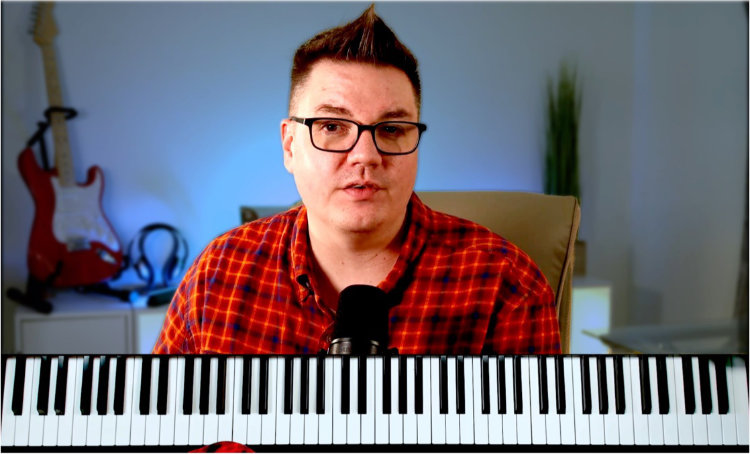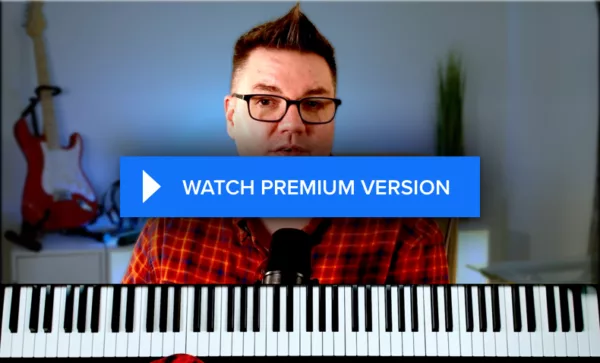When I first started playing jazz from lead sheets I got confused by all the different symbols I saw next to the chord names. Triangles, dashes, circles and more!
Here are some common chord symbols you'll find on lead sheets:
Lead Sheet Chord Symbols
| Symbol Description | Chord Quality | Examples |
|---|---|---|
| Chord with just a “7” | Dominant 7th | “C7” |
| Chord with capitalized “M” | Major 7th | “CM”, “CM7” |
| Chord with lowercase “m” | Minor 7th | “Cm”, “Cm7” |
| Chord with a dash | Minor 7th | “C-“, “C-7” |
| Chord with a triangle | Major 7th | “C△” |
| Chord with a circle | Diminished 7th | “C°” |
| Chord with a circle with a line through it | Half-Diminished | “Cø” |
| Chord with a plus | Augmented Chord | “C+” |
| Chord with a “dim” | Diminished Chord | “Cdim” |
| Chord with a “sus” | Suspended Chord | “Csus”, “Csus4” |
| Chord with m7♭5 | Half-Diminished | “Cm7♭5” |
| Chord with extra numbers | Dominant with extensions | “C7♭9”, “C7♯11”, “C7♭9♭13” |
| Chord with “alt” | Altered Chord | “Calt”, “C7alt” |
| Chord with numbers larger than 7 | Dominant chord with natural extensions | “C9”, “C11”, “C13” |
| Chord with numbers smaller than 7 | Major chord with extra notes | “C6”, “C2”, “C4” |
| Chord with a forward slash | Slash chord | “D/C”, “Bb/F” |
Many of these symbols mean the same thing. It’s up to the composer or engraver to determine which symbol they prefer to use.

Step-by-Step Video Training
As a premium member of Jazz-Library you will have access to our Jazz Fundamentals video course which has 70+ video lessons teaching you all of these chords, how to voice them, and how to use them in songs.
How Chord Symbols are Constructed #
Each chord symbol is constructed from 3 parts, a chord letter, a chord symbol (optional), and a number (also optional).
- Chord Letter: The note that is the root of the chord. eg.
C,Abor another other pitch. - Chord Symbol: A symbolic representation of the chord quality, such as major, minor, or diminished. If this is omitted it implies a major tonality.
- Chord Number: A number indicates additional notes, or extensions to the base chord. If no number is displayed, it classically means to play a triad. But, in jazz circles, its common to assume a 7th chord.
Chord symbols do not need to be followed literally. #
Jazz is the art of improvisation in performance. It's different from classical in that these lead sheets provide a skeleton outline to inspire your own playing. Unlike classical sheet music, the lead sheet does not literally dictate what you should play.
This gives you freedom and responsibility to use your ear and decide for yourself how you want to play this tune.
There are many ways a jazz musician may deviate from these chords:
- Chord extensions and alterations. Even if not notated explicitly, you may choose to include additional notes from the scale, or even altered extensions outside of the scale.
- Chord substitutions. Swapping one chord for another chord of similar function.
- Additional chords. Inserting new chords in places where the chords are not notated to change. For example, turning a
Vchord into aii-V. - Because you want to. The lead sheet is a recommendation, not a requirement. Play whatever you desire and whatever pleases your ear. Make it your own!
Major chord symbols #
One of the most common ways major chords are indicated are without any symbol or number. For example, C on its own would imply a C major chord.
Here are the most common ways to notate a basic C major chord:
CCmajCM(capital "M")
In jazz, we often make any chord a 7th chord, even if it's not notated as such. So, any of those previous examples could also be played as major-7th chords.
It's also quite common to see the major 7th explicitly called for as in the following examples.
CM7C△C△7
* You'll come across a lead sheets which use both a plain C as well as an explicit 7th. This is ambiguous, and may be done accidentally. But in my experience this is also used to indicate that the plain version is intended to be a simple triad. Use your best judgement in this confusing situation!
There's another kind of major chord used in jazz, the major-6th chord. Those are indicated as follows:
C6CM6
Through tradition, a major-6th chord is automatically substituted whenever you see a major-7th chord notated, and the root is in the melody. So, even though you see CM7 notated, if the melody note is C, it usually means C6 anyway.
Minor chord symbols #
Minor chords are very similar to major chords, usually with a lowercase "m" or a dash.
CmCm7C-C-7
Diminished chord symbols #
Diminished chords almost always use a circle as their symbol:
C°C°7CdimCdim7
Half-Diminished chord symbols #
Half-diminished chords usually take two forms, either a circle with a slash (cutting it in "half") or spelled out as a minor-7-flat-5 chord.
CøCø7C-7♭5Cm7♭5
Augmented chord symbols #
The plus sign is pretty universal for augmented chords:
C+C7+5(Dominant 7th with an augmented fifth)
Dominant 7th chord symbols #
Dominant 7th chords are when the symbols start to get a bit unwieldy. They start off simple enough, with a simple numeric extension:
C7
Anytime you see a number larger than 7, it still means dominant, but extended upward to that number. For example, a C9 would also be a dominant 7th chord, but extended to include the 9.
C9C11C13
The symbol may include extended chord alterations as well, such as a flat-9:
C7♭9C7#9C7#11C7#9♭13
When it comes to these altered extensions, there are a couple of things I've observed over the years.
First, many times when you see an extension on a dominant chord in a lead sheet it's because the melody note is itself that extended note. For example, a C7 chord may be listed as a C7#9 if the melody note is an E♭. If you are playing a blues tune, it would be really common to see that flat-3rd (the same as the #9) in the melody. It's part of the blues scale. For this reason, sometimes it's just easier to ignore all the extensions and just figure out for yourself which dominant chord you want to play with the melody note.
The other reason I observe extensions on chords is because it's notated from a specific recording. Even though the extension isn't required, or even part of the original tune, they are included to represent an iconic sound from a specific recording. The Real Booktells you at the bottom of the sheet which recording it was based on, and if you listen to that track, you'll hear those specific voicings. It's up to you if you want to honor that sound, or make it your own.
Suspended chords #
Sus chords are most commonly notated simply with a "sus" suffix. Sometimes they will be more specific, telling you which pitch is suspended, such as the 2nd or the 4th.
CsusCsus2Csus4
The most popular way to voice a suspended chord is as a slash chord, which we'll get to next.
Slash chord symbols #
A slash chord simply indicates that the chord shouldn't have the root in the bass. By default we would play the root of the chord on the bottom, but a slash chord tells us what note to put on the bottom instead.
The note after the slash is the root note. For example C7/G would mean to play a C7 chord, with a G on the bottom.
Sometimes this indicates a specific chord inversion that should be used (such as 2nd inversion, in our previous example). Other times, it may indicate voice leading for the root in a chord progression.
Here's an example showing the root moving in a scale:
CM7-G7/D-A-7/E-FM7-F-7/Ab
